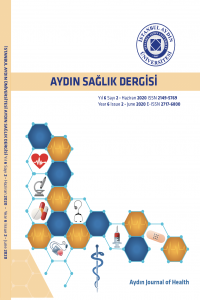İNFRAKLAVİKÜLER BRAKİYAL PLEKSUS BLOKAJINDA EŞİT KONSANTRASYON VE VOLÜMDEKİ BUPİVAKAİN İLE LEVOBUPİVAKAİNİN ETKİNLİĞİNİN KARŞILAŞTIRILMASI
bupivakain, brakial plexus blokajı, levobupivakain
COMPARISON OF THE EFFECTIVENESS OF BUPIVACAINE AND LEVOBUPIVACAINE IN EQUAL CONCENTRATION AND VOLUME IN IFRACLAVICULAR BRACHIAL PLEXUS BLOCKAGE
bupivacaine, levobupivacain, brachial plexus blokage,
___
- Heath P.J., Brownlie G.S., Herrick M.J. : Latency of brachial plexus block Anaesthesia. 45: 297-301, 1990
- Erdine S. : Sinir Blokları. Emre Matbaacılık. İstanbul 49-80, 109-128, 1993
- Borgeat A., Kalberer F., Jacob H., Ruetsch Y.A. : Patient-Controlled Interscalene Analgesia With Ropivacaine 0,2% versus Bupivacaine 0,15% After Major Open Shoulder Surgery: The Effects on Hand Motor Function. Anesth Analg 92: 218-223, 2001
- Eroglu A., Uzunlar H., Sener M., Akinturk Y., Erciyes N. : A Clinical Comparison of Equal Concentration and Volume of Ropivacaine and Bupivacaine for Interscalene Brachial Plexus Anesthesia and Analgesia in Shoulder Surgery. Reg. Anesthesia and Pain Med. 29: 539-543, 2004 Kayhan Z. : Klinik Anestezi Logos Yayıncılık. 439, 441-452, 1997
- Hadzic A., Arliss J., Kerimoglu B. : A comparison of infraclavicular nerve block versus general anesthesia for hand and wrist day case surgeries Anesthesiology. 101(1):127-32, 2004
- Vainionpa V.A., Haavisto E.T., Hulha T.M. : A Clinical cond. Pharmacokinetic comparison of ropivacain and bupivacain in axillary plexus block. Anesth Analg 81: 534-538, 1995
- Casati A., Fanelli G., Capelleri G., Beccaria P. : A clinical comparison of ropivacain 0,75%, ropivacain 1% or bupivacain 0,5% for interscalene brachial plexus anaesthesia European Journal of Anaesthesiology 16: 784-789, 1999
- Kilka H.G., Geiger P., Mehrkens H.H. : Infraclavicular vertical brachial plexus blockade. A new method for anesthesia of the upper extremity. Anaesthesist. 44(5):339-44, 1995
- Krafft P., Eibengberger K., Fitzgerald R. : Ultrasound guided supraclavicular approach for regional anesthesia of the brachial plexus. Anesth Analg. 78: 507-513, 1994
- Neuburger M., Kaiser H., Uhl M. : Biometric data on risk of pneumothorax from vertical infraclavicular brachial plexus block. A magnetic resonance imaging study. Anaesthesist. 50(7):511-6, 2001
- Heid F.M., Jage J., Guth M. : Efficacy of vertical infraclavicular plexus block vs. modified axillary plexus block: a prospective, randomized, observer-blinded study. Acta Anaesthesiol Scand. 2005 May;49(5):677-82
- Rettig H.C., Gielen M.J., Boersma E., Klein J. : A comparison of the vertical infraclavicular and axillary approaches for brachial plexus anaesthesia Acta Anaeshesiol Scand. 49(10): Abstract, 2005
- Grıstwood R.W. : Cardiac and CNS toxicity of levobupivacaine: strengths of evidence for advantage over bupivacaine. Drug Saf. 2002 ; 25 : 153-163 Casati A., Borghi B., Fanelli G., Cerchierini C. : A double-blinded, randomized comparison of either 0,5 % levobupivacaine or 0,5 % ropivacaine for sciatic nevre block. Anesth Analg. 2002 ; 94 : 987-990
- Mcglade D.P., Kalpokas M.V., Mooney P.H. : Comparison of %0.5 Ropivacaine and %0.5 Bupivacaine in Lumbar Epidural Anaesthesia for Lower Limb Orthopaedic Surgery. Anaesth Intens. Care 1997 ; 25 : 262-266
- Crosby E., Sandler A., Finucane B.T. : Comparison of Epidural Anaesthesia with Ropivacaine %0.5 and Bupivacaine %0.5 for Caesarean Section. Canadian Journal of Anesthesia 1998 ; 11 : 45
- Finucane Bt., Sadler A., Mckenna J. : Comparison of Ropivacain %0.05, %0.75, %1.0 and Bupivacaine %0.5 Injected Epidurally, in Patiets Undergoing Abdominal Hysterectomy. Canadian Journal Of Anaesthesia 1996 ; 43 : 5
- Wolff A.P., Hassesrrom L., Kerkkamp H.E. : Extradural Ropivacaine and Bupivacaine in Hip Surgery. Br. J.Anaesth. 1995 ; 74 : 4
- E. Milanesi, S. Betinelli, M. Pedeferri, M. Allegri, F. : Epidural levobupivacaine: Its higher potency guarantees more efficacy and safety than ropivacaine to control postoperative pain? Regional Anesthesia and Pain Medicine 2004 ; 29 ( Suppl. 2 ) : 90
- Ingelmo P.M., Locatelli B.G., Sonzogni V., Gattoni C., Cadisco A. : Caudal 0.2% ropivacaine is less effective during surgery than 0.2% levobupivacaine and 0.2% bupivacaine: a double-blind, randomized, controlled trial. Paediatr Anaesth 2006 Sep;16(9):955 61.
- Frawley G.P., Downie S., Huang G.H. : Levobupivacaine in caudal anesthesia in children: a randomized double-blind comparison with bupivacaine. Paediatr Anaesth. 2006 Jul;16(7):754-60
- ISSN: 2149-5769
- Yayın Aralığı: Yılda 3 Sayı
- Başlangıç: 2015
- Yayıncı: İstanbul Aydın Üniversitesi
ORGANOFOSFAT İNTOKSİKASYONU: TERAPÖTİK AFEREZ UYGULAMASI
Omega-3 Yağ Asitlerinin Kardiyovasküler Hastalıklar Üzerine Etkisi
Hatice ÇİMEN, Yasemin ERTAŞ ÖZTÜRK
DİZDE İNTRAARTİKÜLER LOKALİZASYONLU PAROSTEAL LİPOM OLGUSU
Taha Yasin ARSLAN, Bahar YANIK, Sena YILMAZ, Ahmet ACAN
Ayfer KAYA GÖK, Ülkü Aygen TÜRKMEN
Birinci Basamak Sağlık Hizmetleri Alanında Yapılan Lisansüstü Tezlerin Analizi
Rabia CİVELEKOĞLU, Aysin ERSOY, Muhammed KURNAZ, H Aysel ALTAN
